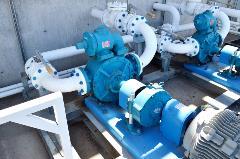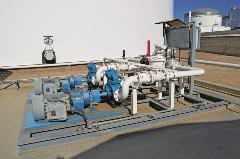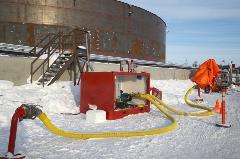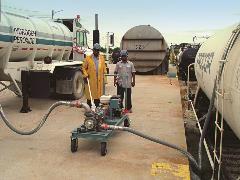STANDARD-SETTING OPERATIONAL EFFICIENCY AND COST-EFFECTIVENESS COMBINED WITH VERSATILE LIQUID-HANDLING CAPABILITIES MAKE SLIDING VANE PUMPS A GO-TO TECHNOLOGY IN STORAGE TERMINALS
By Thomas L. Stone
Introduction
Whether the commodities you deal with are refined fuels (gasoline, diesel, jet fuel, fuel oils, LPG), chemical-based (solvents, acids, pesticides) or food-based (vegetable oils, animal oils, molasses), at some point they will all spend some time at, or simply pass through, a liquid-storage terminal.
The commodities will arrive at the storage terminal via various modes of water-borne and inland transportation – ocean tanker, barge, railcar, pipeline and tank truck chief among them – and in a wide array of volumes, ranging from a few hundred to many thousands of gallons.
With all of these differing commodities continuously crisscrossing the globe in varying amounts and at different speeds, the main job for the storage-terminal operator is twofold: 1) make sure those commodities are where they need to be when they need to be there, and 2) do it in the most efficient, cost-effective and reliable way.
Pumps are a critical link in this supply chain as they are used to load and unload the various varieties of vessels that arrive at the storage terminal. Over the years, different types of pumps have been utilized in storage-terminal applications, with centrifugal and gear styles being common choices. Terminal operators would be wise, however, to consider another type of pumping technology – positive displacement sliding vane – as go-to machines for the transfer of liquids at the many different flow rates, pressures and viscosities that are found in their facilities.
Following are three reasons why sliding vane pumps can outperform their centrifugal and gear cousins in liquidstorage terminal applications.
1) Greater Energy Efficiency
While terminal operators must meet the needs of their customers regarding product storage and transfer, they are also responsible for optimizing energy consumption and costs at their facilities, helping create an optimized bottom line. Sliding vane pumps can assist in this area because their design and method of operation is one of the most energy-efficient among all pumping technologies.
Sliding vane pumps will help storage-terminal operators gain a competitive business advantage because they offer a number of energy- and cost-saving features and benefits in liquid-transfer applications, including:
• Ability to handle thin liquids (gasoline, ammonia, LPG, solvents, etc.) along with those that have viscosities up to 50,000 cSt
• Flow rates up to 2,000 gallons per minute (7,580 L/ min)
• Flow rates proportional to the pump’s speed • Ability to generate high pressure in low-flow applications
• Lower overall cost of ownership when compared to centrifugal pumps
• A design that minimizes energy-robbing pulsation
• Dry-run and self-priming capabilities
• Excellent suction lift and line-stripping capabilities, which is critical for terminal facilities that must clear lines, vessels and storage tanks of residual product
• High volumetric efficiency due to self-adjusting vanes that eliminate energy-robbing slip
• Easy maintenance and vane replacement that does not require the pump to be taken out of service
2) Portability
The versatility of sliding vane pumps enables terminal operators to construct skids that allow the pumps to be moved around the facility to perform multiple liquidtransfer operations. For example, the skids can be placed at railcars on a siding then repositioned between a tank truck and storage tank to facilitate that loading or unloading process.
This portability makes the liquid-transfer process more nimble and versatile, which result in optimized transfer operations with a corresponding reduction in operating costs.
3) Application Versatility
Again, the design and operation of sliding vane pumps make them ideal for use in a variety of liquid-handling applications. While shining in loading or unloading storage tanks, or transferring liquids from one storage tank to another, the operation of sliding vane pumps can also make them a first-choice technology for other common storage-terminal activities. These include the blending, mixing and packaging of raw materials or end products, which can then be loaded onto transport vehicles for further shipment down the supply chain.
The Solution
Blackmer
®, Grand Rapids, MI, USA, is a company whose founder, Robert Blackmer, perfected a new rotary vane pump technology in 1899 that became the predecessor to today's modern sliding vane pumps. Since then, Blackmer has been dedicated to providing the most efficient, safe and reliable pumping products for its customers in many of the world’s most important industries. Blackmer is a brand of PSG
®, Oakbrook Terrace, IL, USA, a Dover company.
Today, many of those customers in the liquid-storage terminal market are striving to optimize the performance of their operations in terms of delivery and storage efficiency, energy use and cost-effectiveness. And many have come to recognize the benefits that sliding vane pumps provide in meeting these important goals. Blackmer recognizes the needs of its customers and has taken great pains to develop and produce sliding vane technologies that play a significant role in improved liquid-handling operations at storage terminals.
Blackmer manufacturers a number of sliding vane pump models that fit the various liquid-handling needs of storage terminals. They include the GNX Series, HXL Series, ML Series, SX Series and STX Series Sliding Vane Pumps. All incorporate the sliding vane principle of operation, which employs a number of vanes that are free to slide into and out of slots on the pump rotor. When the pump driver turns the rotor, the vanes move outward in their slots and bear against the pump’s inner bore casing, creating pumping chambers that transfer a volumetrically consistent amount of liquid, essentially independent of pressure or viscosity.
These operational abilities help make Blackmer sliding vane pumps a leading choice for storage-terminal operators.
Conclusion
According to TankTerminals.com, there are nearly 1,600 terminals in the United States that are dedicated to the storage of various types of commodities and at various capacities. All of these facilities must meet the unique needs of their customers regarding reliability and efficiency, while also satisfying internal demands that they operate at the highest level of cost-effectiveness. As shown, terminal operators who choose to outfit their sites with sliding vane pumps can create many significant
competitive advantages, all of which will play a role in building improved customer relations and a more robust bottom line.
About the Author:
Thomas L. Stone is the Director of Marketing for Blackmer
® and PSG
®. He can be reached at
tom.stone@psgdover.com. For more information on Blackmer’s full line of pumps and compressors, please go to
blackmer.com. Blackmer is a product brand of PSG®, a Dover company, Oakbrook Terrace, IL, USA. PSG is comprised of many of the world’s leading pump brands, including Abaque
®, Almatec
®, Blackmer
®, Ebsray
®, EnviroGear
®, Griswold
™, Mouvex
®, Neptune
™, Quattroflow
™, RedScrew
™ and Wilden
®. You can find more information about PSG at
psgdover.com.

Many liquid-terminal operators are striving to optimize the performance of their facilities in the areas of delivery and storage efficiency, energy consumption and overall cost-effectiveness. A growing number of these operators are discovering that they can achieve their goals through the use of sliding vane pumps.

The cost-effective operation of sliding vane pumps can help storage-terminal operators lower energy use at their facilities, which leads to lower overall operating expense.

Among the many benefits that sliding vane pumps can offer to storage terminals are their ability to handle very-thin liquids along with those that have viscosities to 50,000 cSt.

The versatility of sliding vane pumps makes them ideal for a wide range of storage-terminal applications, including the transfer, blending, mixing and packaging of a varying array of liquids

HXL Series Sliding Vane Pumps are one of the many models that Blackmer
® has developed for use in liquid storage terminals.
[Sidebar]
Talking Transloading
Transloading – defined as the process of transferring a shipment from one mode of transportation to another – may be tangential to the traditional day-to-day operations at some liquid-storage terminals, but there are instances where the increased use of transloading can have benefits for the terminal operator.
Boiled down to its essence, the main objective of transloading is to place commodities as close to the point of final processing, packaging, delivery and consumption as economically possible. It should be no surprise that moving products strictly by truck can be the most expensive form of shipping while also being the least efficient in terms of time required to complete the shipping process.
Creating a transloading operation can overcome the shortfalls of strictly shipping by truck through the incorporation of railcars or barges, which will reduce the number of trucks or truck-miles needed. By extension, this will lower capital costs for the shipper since smaller truck fleets, lower fuel consumption, a leaner driver pool and fewer empty trips will all reduce expenses.
Another economic advantage of transloading is that the process allows for a quick response when inventories need to be replenished, allowing companies to accelerate turnover rates, resulting in reduced inventory costs.
As noted earlier, the portability, versatility and energy-saving efficiencies inherent in the operation of sliding vane pumps can play a role in improving the economic sustainability of transloading operations at storage terminals.
In the end, in instances where transloading is utilized, the many models of Blackmer
® sliding vane pumps that are available to the market can make a case for eventually becoming the standard pumping technology for these operations.
